

Pierre-Simon Laplace. Pierre-Simon, marquis de Laplace (/ləˈplɑːs/; French: [pjɛʁ simɔ̃ laplas]; 23 March 1749 – 5 March 1827) was a French mathematician and astronomer whose work was pivotal to the development of mathematical astronomy and statistics.

He summarized and extended the work of his predecessors in his five-volume Mécanique Céleste (Celestial Mechanics) (1799–1825). This work translated the geometric study of classical mechanics to one based on calculus, opening up a broader range of problems. Adrien-Marie Legendre. Adrien-Marie Legendre (French pronunciation: [adʁiɛ̃ maʁi ləʒɑ̃ːdʁ]) (18 September 1752 – 10 January 1833) was a French mathematician.
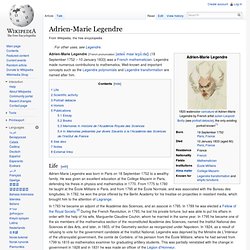
Legendre made numerous contributions to mathematics. Well-known and important concepts such as the Legendre polynomials and Legendre transformation are named after him. Life[edit] Adrien-Marie Legendre was born in Paris on 18 September 1752 to a wealthy family. Joseph Fourier. Biography[edit] Fourier was born at Auxerre (now in the Yonne département of France), the son of a tailor.

He was orphaned at age nine. Sophie Germain. This article is about the mathematician Marie-Sophie Germain.
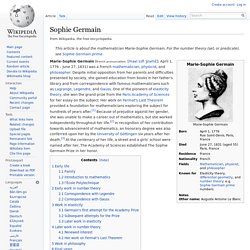
For the number theory (set, or predicate), see Sophie Germain prime. Thomas Young (scientist) Thomas Young (13 June 1773 – 10 May 1829) was an English polymath.

Carl Friedrich Gauss. Johann Carl Friedrich Gauss (/ɡaʊs/; German: Gauß, pronounced [ɡaʊs]; Latin: Carolus Fridericus Gauss) (30 April 1777 – 23 February 1855) was a German mathematician who contributed significantly to many fields, including number theory, algebra, statistics, analysis, differential geometry, geodesy, geophysics, mechanics, electrostatics, astronomy, matrix theory, and optics.
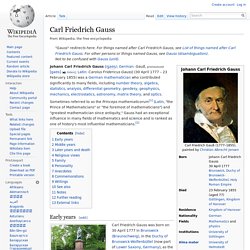
Sometimes referred to as the Princeps mathematicorum[1] (Latin, "the Prince of Mathematicians" or "the foremost of mathematicians") and "greatest mathematician since antiquity," Gauss had an exceptional influence in many fields of mathematics and science and is ranked as one of history's most influential mathematicians.[2] Early years[edit] Gauss was a child prodigy. There are many anecdotes about his precocity while a toddler, and he made his first ground-breaking mathematical discoveries while still a teenager.
The year 1796 was most productive for both Gauss and number theory.
Daniel Bernoulli. Daniel Bernoulli FRS (/bərˈnuːli/; Swiss [bɛʁˈnʊli];[1] 8 February 1700 – 17 March 1782) was a Swiss mathematician and physicist and was one of the many prominent mathematicians in the Bernoulli family.
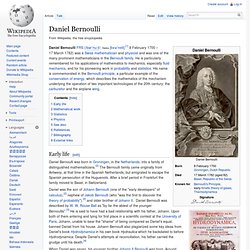
He is particularly remembered for his applications of mathematics to mechanics, especially fluid mechanics, and for his pioneering work in probability and statistics. His name is commemorated in the Bernoulli principle, a particular example of the conservation of energy, which describes the mathematics of the mechanism underlying the operation of two important technologies of the 20th century: the carburetor and the airplane wing.
Thomas Bayes. Thomas Bayes (/ˈbeɪz/; c. 1701 – 7 April 1761)[1][2][note a] was an English statistician, philosopher and Presbyterian minister, known for having formulated a specific case of the theorem that bears his name: Bayes' theorem.

Bayes never published what would eventually become his most famous accomplishment; his notes were edited and published after his death by Richard Price.[3] Biography[edit] Leonhard Euler. A statement attributed to Pierre-Simon Laplace expresses Euler's influence on mathematics: "Read Euler, read Euler, he is the master of us all.
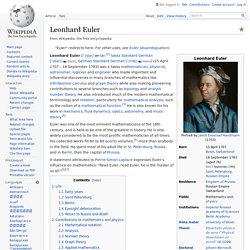
"[6][7] Jean le Rond d'Alembert. Johann Heinrich Lambert. Johann Heinrich Lambert (German: [ˈlambɛʁt], Jean-Henri Lambert in French; 26 August 1728 – 25 September 1777) was a Swiss mathematician, physicist, philosopher and astronomer.
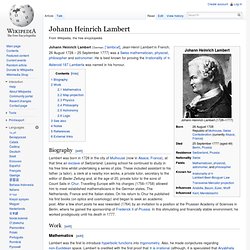
He is best known for proving the Irrationality of π. William Herschel. Early life and musical activities[edit] Herschel was born in the Electorate of Hanover, part of the Holy Roman Empire, one of ten children of Isaac Herschel by his marriage to Anna Ilse Moritzen. His family were Lutheran Christians, probably descended on his father's side from converted Moravian Jews.[2][3] His father was an oboist in the Hanover Military Band.
In 1755 the Hanoverian Guards regiment, in whose band Wilhelm and his brother Jakob were engaged as oboists, was ordered to England. At the time the crowns of Great Britain and Hanover were united under King George II. As the threat of war with France loomed, the Hanoverian Guards were recalled from England to defend Hanover. Original manuscript of Symphony No. 15 in E flat major (1762). Herschel moved to Sunderland in 1761 when Charles Avison immediately engaged him as first violin and soloist for his Newcastle orchestra, where he played for one season. Edmond Halley. Joseph Louis Lagrange. Joseph-Louis Lagrange (born Giuseppe Lodovico Lagrangia [1][2][3] (also reported as Giuseppe Luigi Lagrangia [4]), 25 January 1736 in Turin, Piedmont; died 10 April 1813 in Paris) was an Italian Enlightenment Era mathematician and astronomer.
He made significant contributions to the fields of analysis, number theory, and both classical and celestial mechanics. In 1766, on the recommendation of Euler and d'Alembert, Lagrange succeeded Euler as the director of mathematics at the Prussian Academy of Sciences in Berlin, Prussia, where he stayed for over twenty years, producing volumes of work and winning several prizes of the French Academy of Sciences.
Lagrange's treatise on analytical mechanics (Mécanique Analytique, 4. ed., 2 vols. Paris: Gauthier-Villars et fils, 1888–89), written in Berlin and first published in 1788, offered the most comprehensive treatment of classical mechanics since Newton and formed a basis for the development of mathematical physics in the nineteenth century.